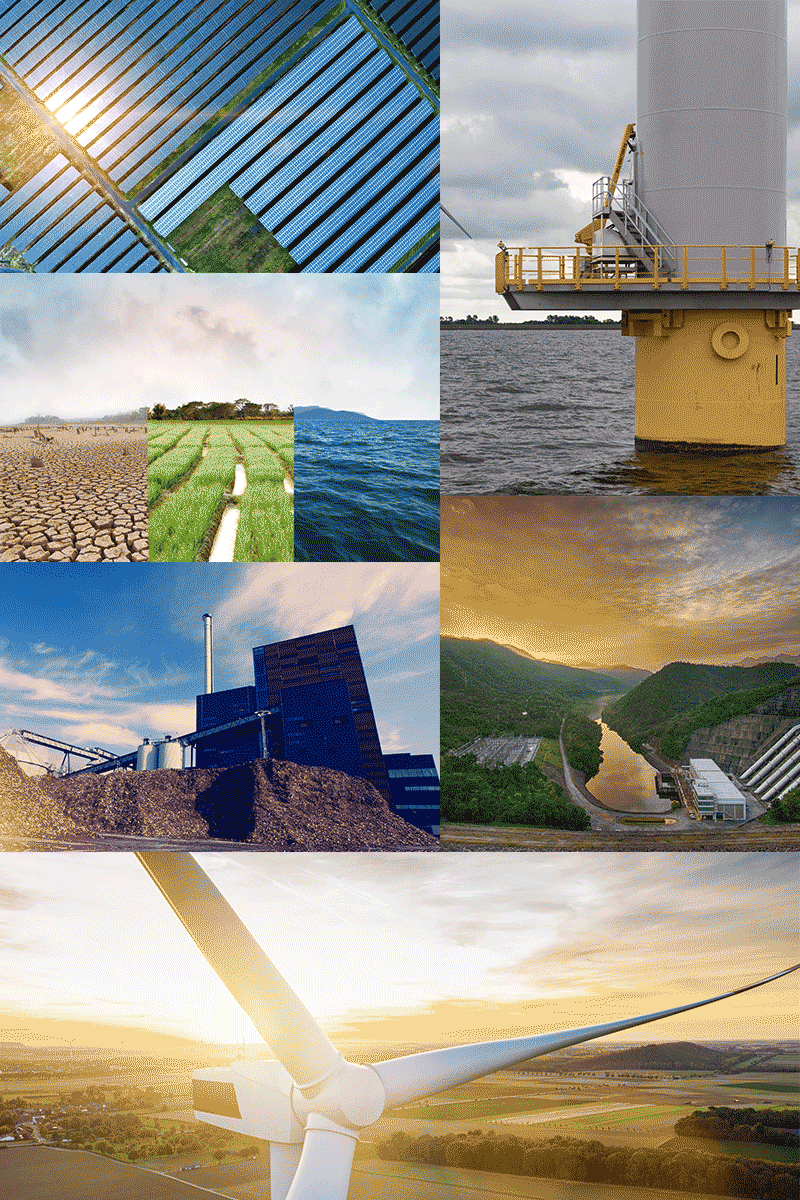Limiting global warming to 1.5°C goes hand in hand with shaping a prosperous, inclusive and sustainable world.
With investment in energy transformation, it's possible.
Scroll/
Holding the Line on Rising Global Temperatures/
Limiting global warming to 1.5°C goes hand in hand with shaping a prosperous, inclusive and sustainable world.
With investment in energy transformation, it's possible.
Turning ambition into action
We have 11 years to set the world on a 1.5°C path and avoid catastrophic consequences of climate change, according to the 2018 IPCC special report.
Whilst the world is in the midst of a social and economic transformation with the global energy system entering a period of unprecedented change, fulfilling the objectives of Paris Agreement means deploying renewables six times faster.
Currently, we are not on track.

90% of the energy-related emissions reduction can be achieved through accelerated uptake of renewables and energy efficiency underpinned by extensive electrification.

90% of the energy-related emissions reduction can be achieved through accelerated uptake of renewables and energy efficiency underpinned by extensive electrification.
Renewables are at the heart of the solution
With rapid uptake of renewables, energy emissions would be 70% lower than today. Falling technology costs have made solar, wind and other renewables the competitive backbone of energy decarbonisation.
Putting the world on a climate-proof energy path calls for additional investment.
But the energy transition pays off with economic, health and environmental benefits reaching USD 65 to USD 160 trillion.
A channel for sustainable investment
A decarbonised global energy system requires scaling-up annual investments in the energy sector.
Annual renewable energy investments for the next decade need to double from around USD 330 billion to nearly USD 750 billion per year until 2030, and continue along that scale to 2050.
In addition, nearly USD 18.6 trillion of planned investment in fossil fuels need to be redirected towards energy efficiency, renewables and enabling infrastructure.
Renewable energy investment
Investment (USD billions)
Source: IRENA
Investment at the necessary scale is possible/
Global
USD 2 667 billion
Renewables: USD 735 billion
Energy efficiency: USD 1 099 billion
Electrification of heat and transport: USD 374 billion
Power grids and flexibility: USD 372 billion
Others: USD 86 billion
(includes hydrogen electrolysers, biofuels supply, CCS)
(includes hydrogen electrolysers, biofuels supply, CCS)
North America
USD 487 billion
Renewables: USD 119 billion
Energy efficiency: USD 221 billion
Electrification of heat and transport: USD 74 billion
Power grids and flexibility: USD 65 billion
Others: USD 8 billion
(includes hydrogen electrolysers, biofuels supply, CCS)
(includes hydrogen electrolysers, biofuels supply, CCS)
Latin America
USD 118 billion
Renewables: USD 31 billion
Energy efficiency: USD 59 billion
Electrification of heat and transport: USD 10 billion
Power grids and flexibility: USD 15 billion
Others: USD 3 billion
(includes hydrogen electrolysers, biofuels supply, CCS)
(includes hydrogen electrolysers, biofuels supply, CCS)
Rest of Europe
USD 165 billion
Renewables: USD 25 billion
Energy efficiency: USD 94 billion
Electrification of heat and transport: USD 30 billion
Power grids and flexibility: USD 6 billion
Others: USD 10 billion
(includes hydrogen electrolysers, biofuels supply, CCS)
(includes hydrogen electrolysers, biofuels supply, CCS)
Middle East and North Africa
USD 148 billion
Renewables: USD 18 billion
Energy efficiency: USD 96 billion
Electrification of heat and transport: USD 5 billion
Power grids and flexibility: USD 23 billion
Others: USD 6 billion
(includes hydrogen electrolysers, biofuels supply, CCS)
(includes hydrogen electrolysers, biofuels supply, CCS)
Sub-sahara Africa
USD 105 billion
Renewables: USD 43 billion
Energy efficiency: USD 25 billion
Electrification of heat and transport: USD 16 billion
Power grids and flexibility: USD 18 billion
Others: USD 3 billion
(includes hydrogen electrolysers, biofuels supply, CCS)
(includes hydrogen electrolysers, biofuels supply, CCS)
Oceania
USD 34 billion
Renewables: USD 13 billion
Energy efficiency: USD 13 billion
Electrification of heat and transport: USD 3 billion
Power grids and flexibility: USD 4 billion
Others: USD 1 billion
(includes hydrogen electrolysers, biofuels supply, CCS)
(includes hydrogen electrolysers, biofuels supply, CCS)
South-east Asia
USD 141 billion
Renewables: USD 45 billion
Energy efficiency: USD 56 billion
Electrification of heat and transport: USD 11 billion
Power grids and flexibility: USD 22 billion
Others: USD 7 billion
(includes hydrogen electrolysers, biofuels supply, CCS)
(includes hydrogen electrolysers, biofuels supply, CCS)
East Asia
USD 763 billion
Renewables: USD 268 billion
Energy efficiency: USD 229 billion
Electrification of heat and transport: USD 139 billion
Power grids and flexibility: USD 105 billion
Others: USD 22 billion
(includes hydrogen electrolysers, biofuels supply, CCS)
(includes hydrogen electrolysers, biofuels supply, CCS)
Rest of Asia
USD 376 billion
Renewables: USD 93 billion
Energy efficiency: USD 157 billion
Electrification of heat and transport: USD 54 billion
Power grids and flexibility: USD 52 billion
Others: USD 20 billion
(includes hydrogen electrolysers, biofuels supply, CCS)
(includes hydrogen electrolysers, biofuels supply, CCS)
European Union
USD 323 billion
Renewables: USD 82 billion
Energy efficiency: USD 147 billion
Electrification of heat and transport: USD 33 billion
Power grids and flexibility: USD 56 billion
Others: USD 5 billion
(includes hydrogen electrolysers, biofuels supply, CCS)
(includes hydrogen electrolysers, biofuels supply, CCS)
Electrification of end-use sectors is key
The share of electricity in total final energy use will need to increase from 20% today to almost 50% by 2050.
Electric mobility will significantly reduce fossil fuel emissions in the transport sector.
Developing and deploying renewable solutions for buildings, urban development projects and industries is key.
Around 8% of the electrification share in final consumption would be attributed to renewable hydrogen.
Strong business case of renewables
Renewable technologies are increasingly becoming the least-cost energy supply option worldwide.
In 2020, all renewables technologies will be within the fossil-fuel cost-range.
Transformation of economies and societies
Every dollar spent can bring returns as high as seven dollars in fuel savings, avoided investments and reduced health and environmental damage.
New jobs, new industries and sustainability for all
Renewable energy drives a low-carbon economic growth. The energy sector plays the dual role of fuelling economy-wide development and supporting many jobs.
Today, 11 million people are employed in renewable energy. The energy transition will increase employment in the energy sector, most significantly in renewables, as well as in the broader economy.
Government plans still fall short
Accelerating the deployment of renewable energy requires policies and market design that create an enabling environment for investment.
Renewable energy features in 87% of the 156 Nationally Determined Contributions (NDCs). 104 of these include quantified targets for renewable energy.
National energy policies are even more ambitious. Today, more than 50 countries target 100% renewable power generation.
A climate-safe, sustainable energy system for all is a shift in investments and mindsets.
Lead the change. It’s possible.
